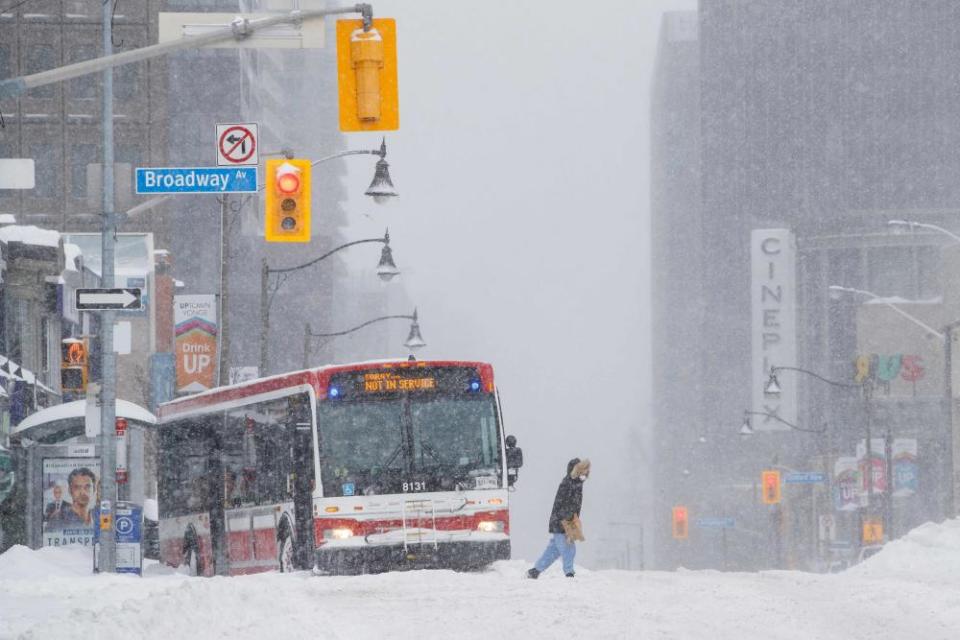Toronto’s struggles with blizzard highlights its dependence on cars
When a blizzard struck Toronto earlier this week, Greg Cooke did what he and his neighbours knew was expected of them. They grabbed their shovels and worked for hours to clear the sidewalks from snowdrifts that nearly reached their knees. Mindful of elderly residents with trouble walking, they made sure to clear all the way to the edge of the street.
The next morning, Cooke went outside to find a snowplow had passed through once again to widen the road and pushed all the snow back on to the sidewalk.
“They push up these solid, chunky boulders of snow. And so it was even worse for people to pass through than it would have been if we hadn’t done anything,” said Cooke. “It was comically absurd.”
Yesterday at noon. Did my civic duty. The road had been plowed, emergency vehicles could get through, cars were fine once they got out of driveways. Today? Plows made sidewalks impassable. Drivers are pampered, pedestrians get nothing.@gordperks #TOpoli pic.twitter.com/Pt9ssGHtaS
— Greg Cooke (@CookieInTO) January 18, 2022
Monday’s storm battered the country’s largest city for less than a day, but its effects have nonetheless highlighted Toronto’s infrastructure vulnerabilities, its lingering inequities – and its dependence on cars.
While the city’s struggles with snow have often prompted sneers from other regions of the country – Toronto’s government is still mocked for calling in the army to help dig it out from a series of relentless snowfalls in 1999 – critics say many of the challenges are the result of policy failures that prioritize vehicles over pedestrians.
At its peak, Monday’s blizzard left hundreds of cars stranded on roads and highways across the city, with many of the vehicles simply abandoned by frustrated drivers
The city’s transit commission said during the worst of the storm, 540 buses were stranded on the road for hours – including one salvaged by a group of Torontonians – and the subway system was forced to shut down.

The city’s mayor, John Tory, warned on Tuesday that it would take days to get the roads fully cleared, and 600 road plows, 360 sidewalk plows and 200 salt trucks were deployed.
But on Wednesday, residents were still posting images of sidewalks and bike lanes fully covered in snow. Meanwhile, the city’s school board announced eight schools would remained closed for a third day after the contractor hired to remove snow was unable to complete the work.
“The last couple days have highlighted how close to failure our transportation system operates all the time – because we base it around cars,” said Shoshanna Saxe, a civil engineering professor at the University of Toronto.
“For those of us who had the privilege of not needing to drive anywhere, it was a fun day in the snow. But for people who needed to drive, they were forced to take risks. Some were stranded for hours on highways. Doctors and nurses had to abandon their cars in the road to get to hospitals in the middle of the biggest wave of Covid we’ve ever seen,” she said.
Saxes pointed to recent efforts in Sweden, where sidewalk clearing is prioritized ahead of roads. The aim of policies is to address systematic shortcomings that have an outsized effect on people with mobility issues, including those in wheelchairs, health issues and parents pushing small children in strollers.
“When you decide not to plow a certain neighbourhood for a few days, you’re also now limiting the ability for someone with a disability to actually leave their home,” said Maayan Ziv, a Toronto-based photographer and founder of AccessNow. “Accessibility, in general, is often an afterthought.”
Because she relies on a power wheelchair to move around the city, Ziv says the snow often forces her to cancel meetings and appointments and can strand her at home for days.
Related: 'Pure joy': refugees fleeing conflict delighted by first snow in Canada
Toronto city council recently approved nearly C$1.4bn ($US1.1bn) in spending on future snow clearing – a victory for residents who have long complained that sidewalks are inaccessible. But the winning bidders in the contract have warned it could take more than a year to obtain the hundreds of vehicles needed to do the job.
“We live in this cold part of the world where it does snow every year, and yet, we’re still facing these issues. And when the city is failing to recognize those needs, it falls in on kind of the goodwill of neighbours,” said Ziv. “There is beauty in that and people working together and supporting each other. But an entire city can’t – and shouldn’t – rely on good Samaritans with their shovels”

 Yahoo Movies
Yahoo Movies 
